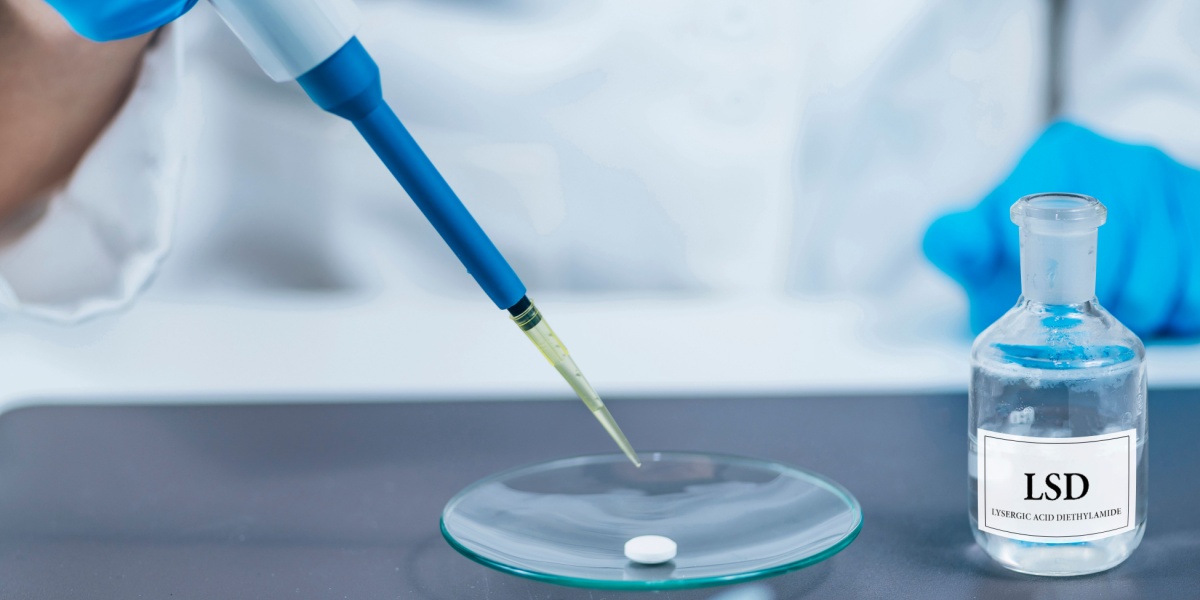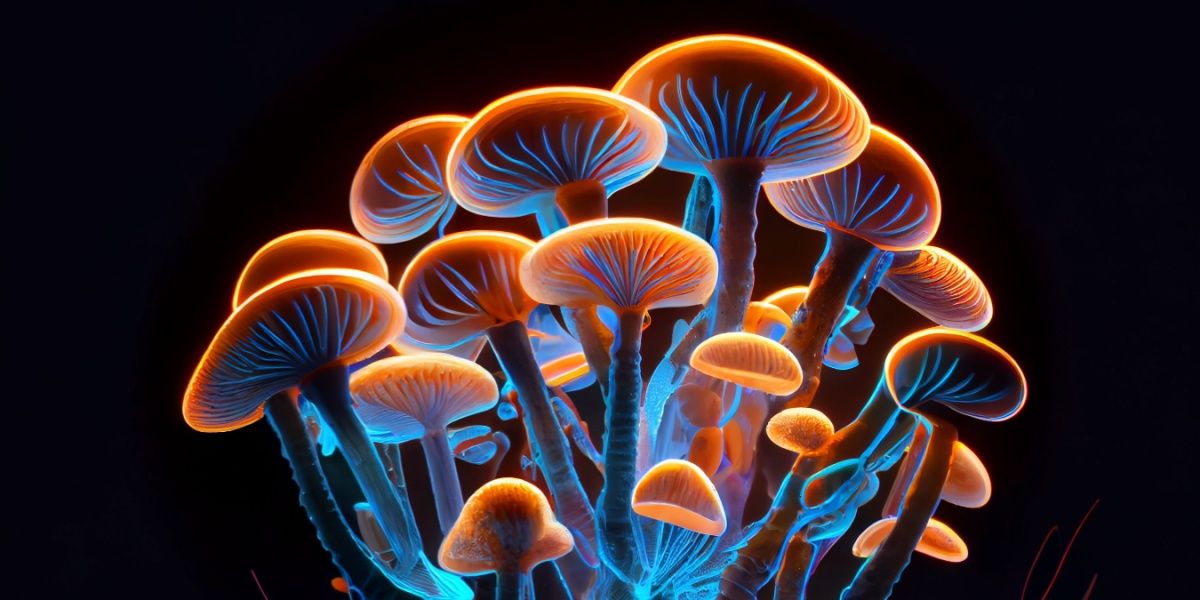Lysergic acid diethylamide (LSD) is one of the most potent psychedelic substances known, capable of producing profound changes in perception and consciousness. First synthesized in 1938, its psychoactive effects were only discovered years later.
Despite being classified as a Schedule I controlled substance under U.S. law, research into its therapeutic potential in mental health treatment continues, raising complex legal, medical, and ethical questions.
- LSD is built around an indole ring from lysergic acid (from ergot), with only the d-LSD isomer being psychoactive.
- LSD’s production involves controlled steps, activating lysergic acid with thionyl chloride and reacting it with diethylamine.
- The process uses illegal chemicals, posing significant safety and environmental dangers.

LSD's chemical makeup and synthesization
Lysergic acid diethylamide (LSD) is a semi-synthetic compound derived from lysergic acid, a naturally occurring molecule found in the ergot fungus (Claviceps purpurea) that grows on grains. [1] Its structure includes an indole ring, a structural feature that allows LSD to bind to serotonin receptors in the brain, producing its characteristic psychedelic effects. [1]
Swiss chemist Albert Hofmann first synthesized LSD in 1938 while researching ergot derivatives for potential pharmaceutical uses. [2] Its psychoactive properties weren’t discovered until 1943, when Hofmann inadvertently absorbed a small dose, leading to the first recorded LSD experience. While the exact mode of exposure remains debated, it likely involved oral ingestion rather than skin contact.
LSD is made by combining natural and synthetic ingredients. The process begins with lysergic acid, a compound derived from ergot fungus, which grows on grains. Chemists convert this into LSD by attaching a diethylamide group, creating a substance that interacts powerfully with the brain’s serotonin system. [3]
Only one form of LSD, called d-LSD, produces psychedelic effects. This form fits precisely into serotonin receptors (especially the 5-HT₂A receptor), which help regulate mood and perception. [4] This interaction is what triggers LSD’s intense alterations in thought and experience.
Ingredients used to make LSD
LSD is synthesized through a complex chemical process involving a range of organic solvents, acids, and reagents, many of which are hazardous and tightly regulated. [1][2][3][5][6][7][8][9]
- Lysergic acid
- Diethylamine
- Thionyl chloride (SOCl₂)
- Dichloromethane (DCM)
- Ethanol
- Methanol
- Sodium hydroxide
- Potassium hydroxide
- Chromatographic materials (like silica gel)
- Acid/base pairs (like tartaric acid)
- Diethyl ether
- Chloroform
- Acetone
Note: This list identifies chemicals associated with LSD synthesis in historical or theoretical contexts. LSD production is illegal and highly dangerous.
The process of making LSD
Disclaimer: This overview is provided for educational and historical context only. It is not intended as, nor should it be used as, a guide for illegal or dangerous activities. The production of LSD is hazardous, illegal, and not recommended. This platform does not endorse or recommend illegal or unsafe activities.
Since LSD was first synthesized in 1938 by Swiss chemist Albert Hofmann, methods have since evolved, and most production methods of LSD follow a similar multi-step process requiring advanced chemical knowledge and controlled laboratory conditions. [2]
Sourcing lysergic acid
The process begins with obtaining lysergic acid, an ergot fungus compound that infects rye grains. Historically, this involved breaking down ergot alkaloids, such as ergotamine, through chemical reactions. While some plants (like morning glory seeds) contain related compounds (including LSA), these are distinct from the lysergic acid needed for LSD. [10][11][12]
Converting lysergic acid into a reactive form
The lysergic acid must be converted into a reactive intermediate, allowing it to combine with other molecules. This step typically involves chemical reagents that prepare the molecule for further modification. [3][11]
Formation of LSD
The reactive intermediate is then combined with diethylamine, which completes the structure of LSD. This step requires careful conditions to prevent contamination and degradation of the final product. [3][5]
Purification
The resulting material contains impurities and byproducts. Various purification methods, like chromatography and recrystallization, are used to isolate LSD and ensure its stability by forming a salt, such as LSD tartrate. [1][9][13]
Quality control
In professional laboratories, analytical techniques, such as high-performance liquid chromatography (HPLC) or nuclear magnetic resonance (NMR) spectroscopy, confirm the purity and chemical structure of LSD. This ensures that the psychoactive form, (+)-d-LSD, is present. [11][14]
Challenges in illicit production
Outside of controlled settings, producing LSD is highly difficult. The compound is sensitive to heat, light, and moisture, which can degrade it quickly. In illicit environments lacking precise control, the product usually has low purity and unpredictable potency. [10]
Why LSD production is dangerous and illegal
The production process of LSD poses a risk to public safety. It is also a federal crime in the United States. Below are reasons why LSD production is considered exceptionally dangerous and unlawful:
Chemical and physical hazards
LSD synthesis requires volatile substances, like thionyl chloride (SOCl₂), which reacts violently with water to release corrosive hydrochloric acid (HCl) and sulfur dioxide (SO₂) gases, posing severe inhalation and chemical burn risks. [15]
Solvents, such as dichloromethane (a suspected carcinogen) and barium hydroxide (highly corrosive), are commonly used in clandestine labs, increasing the risks of burns, poisoning, or explosions in poorly ventilated settings. [1][5]
Health risks from impure products
Illicit LSD production often results in contaminated substances. Byproducts like iso-LSD (non-psychoactive) or residual solvents (e.g., chloroform) remain in the final product because of inadequate purification. [1] While LSD itself is less acutely toxic, impurities and erratic dosing can lead to unpredictable psychological effects, accidents, or exacerbation of pre-existing mental health conditions. [12]
Criminalization
Under the Controlled Substances Act (CSA) of 1970, LSD is classified as a Schedule I drug, meaning it has “no accepted medical use” and a “high potential for abuse.” [15] Manufacturing, distributing, or possessing LSD may impose sentences of up to 20 years in prison for first-time offenders. [16]
Law enforcement prioritization
The DEA categorizes LSD as a “high-priority” controlled substance because of its association with unregulated black markets and public health risks. Clandestine lab raids frequently uncover hazardous chemical waste. This is concerning, especially regarding the broader dangers these operations pose to communities. [5][14]
Technical challenges amplify risks
Even skilled chemists struggle to produce pure LSD. It degrades rapidly under heat, light, or moisture. Thus, advanced storage methods are required, which are absent in illicit labs. [1] Most illicit LSD is impure and adulterated, heightening the risks of using it. [12]
Ethical and medical perspectives on LSD production
The production of LSD evokes ethical and medical concerns, especially in weighing potential small therapeutic benefits against known grave societal risks and legal constraints.
Ethical perspectives
- Some people contend that criminalizing LSD manufacturing enables unregulated markets, increasing the risks of contaminated products and limiting access to therapeutic research. [17] However, LSD’s Schedule I classification under the CSA in the U.S. reflects concerns about its potential for misuse and psychological harm. [14]
- Because LSD’s Schedule I status imposes stringent licensing requirements, it stifles studies on its therapeutic potential. For example, early-phase trials of LSD-assisted therapy for anxiety and depression are delayed because they face significant regulatory hurdles. [1][18]
- Illicit LSD labs often dispose of toxic waste (e.g., solvents, heavy metals) irresponsibly, disproportionately affecting marginalized communities. Direct studies on LSD production’s environmental impacts are limited; parallels can, however, be drawn from methamphetamine lab contamination, where hazardous waste disposal contributes to public health risks. [8][14]
Medical perspectives
- LSD holds potential for treating anxiety, depression, and addiction, as well as LSD-assisted psychotherapy for end-of-life anxiety. [18] Such research relies on pharmaceutical-grade LSD, which is inaccessible due to production restrictions. [1]
- LSD made in underground labs is often contaminated with inactive byproducts (e.g., iso-LSD) or residual solvents (e.g., chloroform); this may result in unpredictable effects and hospitalizations. [5] While LSD use alone is less likely to cause acute toxicity, impurities and erratic dosing can lead to adverse health outcomes. [12]
- Advocates support regulated LSD production for research purposes, as this could minimize diversion. Skeptics, on the other hand, worry about the challenges of secure supply chains, given LSD’s high potency and historical misuse. [19]

-person-thumbnail.jpg?v=1758880627)

-guide-detail.jpg?v=1756808816)
